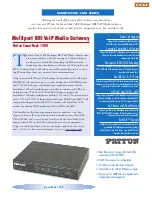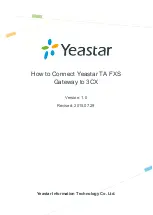
HTTP 401 Authorization.
In this mode, the 401 authorization method specified in the HTTP
standard is used for challenging the user his/her username and password. The username and
password information is encrypted by the Base64 algorithm. After the
Log On
button on the
log-on page is clicked, a window appears for the user to enter his/her username and password.
CGI without Encryption.
In this mode, the user enters his/her username and password directly
on the log-on page, and then clicks the
Log On
button to log on. The username and password
information is transmitted from the client computer to the gateway in plaintext.
CGI with Base64.
In this mode, the user enters his/her username and password directly on the
log-on page, and then clicks the
Log On
button to log on. The username and password informa-
tion transmitted from the client computer to the gateway is encrypted by the Base64 algorithm.
CGI with SSL.
In this mode, the user enters his/her username and password directly on the
log-on page, and then clicks the
Log On
button to log on. The username and password informa-
tion transmitted from the client computer to the gateway is encrypted by SSL (Secure Socket
Layer).
NOTE:
The gateway is equipped with a default certificate and a private key for SSL operations.
As an alternative, you can use a certificate file and a private key file, both of which issued by a
CA (Certificate Authority) that you trust. Section 3.3.3.6 describes how to upload a certificate
file and a private key file to the gateway.
TIP:
If you have uploaded a certificate file and a private file to the gateway and the
CGI with
SSL
option is chosen, make sure the
host name
and
domain (DNS suffix)
settings of the gate-
way’s LAN interface correspond with those contained in the certificate file. This way, the Web
browser on the client computer will not warn the user to verify the certificate during SSL hand-
shaking between the gateway and the client computer.
When a wireless user tries to access the Internet, he/she is redirected to a
Default log-on page
or a
page stored on an external Web server (
The following URL
), depending on the network administra-
tor’s choice.
Fig. 79. Default log-on page.
NOTE:
If the
CGI with SSL
mode is chosen and an external log-on page is used, make sure the URL
of the external log-on page is HTTPS-based.
After the wireless user passes authentication, the wireless user can be brought to the originally re-
quested Web page (
Original URL requested by the user
) or to a default page for advertisement
purposes
(The following URL
). For example, if “http://www.wi-fi.com” is set for
The following
URL
, the user will be brought to the home page of Wi-Fi Alliance.
In addition, the
Log-Off
window is also shown after the wireless passes authentication. The
Log-Off
window can be configured to contain the
Default log-off page
or a page stored on an external Web
server (
The following URL
).
57
Содержание IWE1200A-G
Страница 1: ...USER S MANUAL...
Страница 14: ...7...
Страница 72: ...Fig 95 Advertisement links settings Fig 96 Advertisement links in action 65...
















































